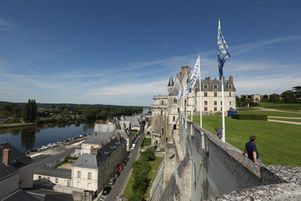Paris and the Heart of France

Day 6 - The Amazing Chenonceau
I got up early to take pictures along the Loire River before breakfast, which included an obligatory chocolate croissant.
We then boarded our bus to the picturesque Chateau de Chenonceau, While it doesn't have the size of Chambord, it more than makes up for it with its beautiful location and construction all the way across the Le Cher River.

More importantly, Chenonceau's furniture, furnishings and art are all original as they were spared from the French Revolution, because at that point it was not owned by the crown. You definitely want to look at the artwork, as it includes works by Rubens, Ribera, Ribalto, Tintoretto, Van Loo and Van Dyck.
To get the most out of your visit, make sure to purchase the audio guide along with your entry ticket (at the parking lot). Unfortunately, the audio guide cannot be purchased where you pick it up (just inside the chateau).
Antoine took us through some of the gardens, past a pigeon coop, and then we played the name game before crossing the drawbridge for our self-guided tour (get the audio guide).

Chenonceau was built between 1513 and 1517 by Thomas Bohier who handled finances for Kings Louis XI, Charles VIII, Louis XII, and François I. Although Bohier's wife Katherine largely oversaw the project.
King François I took possession of the chateau after Thomas Bohier died. King Henry II gave it to his mistress Diane de Poitiers.
During a marriage celebratory jousting tournament, King Henry II insisted on one more match and chose the captain of his own guard. Unfortunately, the captain's lance broke, traveled up under King Henry II's helmet, and mortally wounded him in the eye. Needless to say, the captain lost his job.
The moment Henry II died, his now widow, Queen Catherine de Medici, quickly kicked Diane the mistress out. C'est la vie.
Catherine de Medici instilled power on her eight-year-old son, Henry III, but she "ruled" France as Regent from Chenonceau. Tragedy struck again when King Henry III was assassinated by a monk, just before his 30th birthday. Catherine de Medici would die just 8 months after her son.

Henry III's wife, Louise de Lorraine, would spend the rest of her life at Chenonceau mourning his death, wearing white, but living in a dark room painted black. Thus ended the royal history of Chenonceau.

We enjoyed the great hall built over the river, seeing the historical displays, and how Chenonceau once housed wounded allied troups. I was disappointed that we were not allowed to exit out the other side of the bridge to take pictures. Oh well. C'est la vie.
Chenonceau is a must-see and one of the absolute highlights of our trip!
Spoiler alert: If you want to see even more of what's in store for you, check out Google Arts and Culture amazing virtual exhibition of Chenonceau's art which shows the content and context in greater detail.
We headed back to Amboise where we had the rest of the day free. We went to Restaurant La Florentine (50 Place Michel Debré, 37400 Amboise, France) and sat in the back covered patio area. While it didn't have the view, it was quiet, cool, the food was great, and we got quick service.

Then we joined our guide, and most of the group, for an optional tour/walk up to Clos Lucé, the home of Leonardo da Vinci.
I really enjoyed seeing original windows, recreated workshop and period furniture and imaging what it would have been like. Leonardo brought the Mona Lisa as well as other paintings with him to Close Lucé, where he would eventually die.

Downstairs there was a museum with models of many of his inventions, which was quite interesting.
We were able to see a special exhibit that was part of the 500 year anniversary of Da Vinci's death. The exhibit featured a giant pre-1514 tapestry of Da Vinci's Last Supper painting that was given by King François I to the Pope for blessing the marriage of Henry II to Catherine de Medici. It was described as the greatest tapestry ever woven of silk and silver. Recently restored, this was the first time the tapestry of the Last Supper had been displayed outside of the Vatican Museum.

From there, after an obligatory stop for gelato at Amorino, I headed up to the Chateau Royal d'Amboise, a massive complex with breathtaking views overlooking Loire Valley, the town, and our hotel right below. The Chateau has a storied history and was a residence to the kings, queens and the royal court from the 15th to 19th centuries. The complex was most impressive during the reign of Charles VI, but sadly much of that is now gone. What is left is still worth seeing, including two very impressive spiral staircases, wide and tall enough for men riding horses, as well as horse-drawn carriages to travel some 130 feet up or down to the town below.

Schedule

One of the highlights was a 1781 painting by Francois-Guilaume Menageot, depicting the death of Leonardo da Vinci in the arms of François I. Louis XVI liked the painting so much, he paid 4,000 pounds of silver for it, and then commissioned a tapestry of it, now found in the Quinirale Palace in Rome.

The chateau has other connections to Leonardo, which at one time, believe it or not, included a tunnel that ran all the way to Leonardo's house. The chateau also houses a small chapel (overlooking the town) that houses Leonardo da Vinci's tomb.
During summer evenings, they hold Renaissance spectaculars in the royal courtyard that combine projected multimedia with sound, and some 250 live actors, to tell stories about those who lived, and died at the chateau.
We had a great dinner at L'Ambaccia (16 Place Michel Debré, 37400 Amboise) and enjoyed a walk along the Loire, and across the bridge, before heading back to our hotel.



































